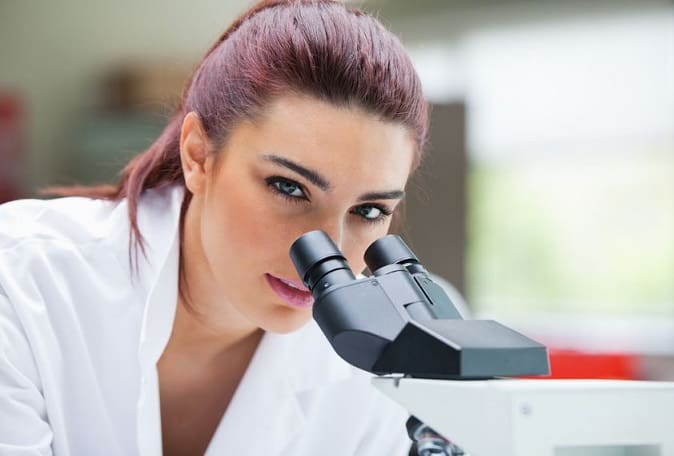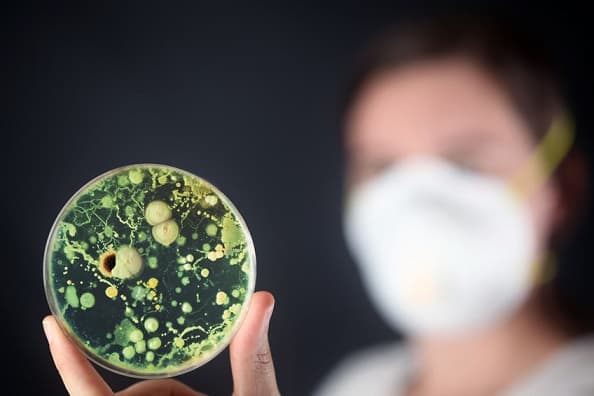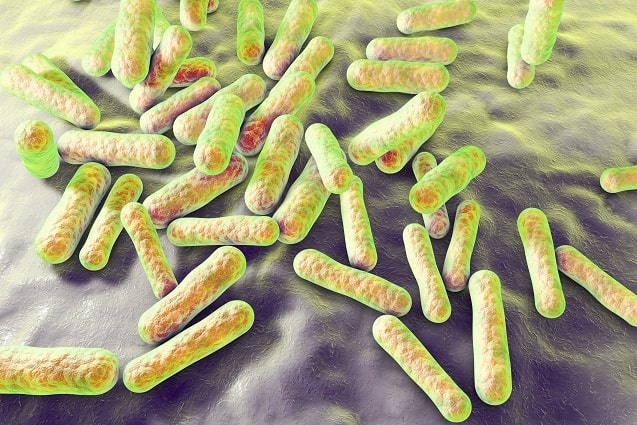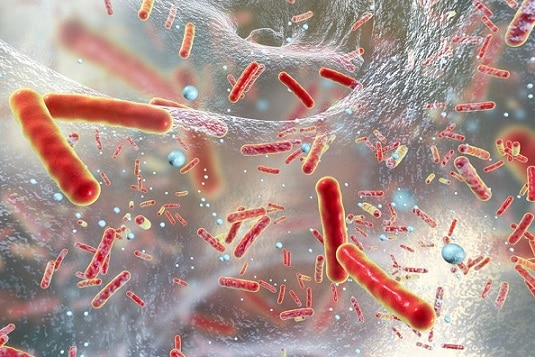 Scrolling through antibacterial facewashes on the internet, the most common target of their ingenious recipes 20 years in the making is said to be bacteria. Specifically, they mean propionibacterium acnes (or p.acnes), the oxygen fearing strain which is perfectly adapted to clogged skin pores. “Kills harmful bacteria” and “proven antibacterial properties” are common claims…
Scrolling through antibacterial facewashes on the internet, the most common target of their ingenious recipes 20 years in the making is said to be bacteria. Specifically, they mean propionibacterium acnes (or p.acnes), the oxygen fearing strain which is perfectly adapted to clogged skin pores. “Kills harmful bacteria” and “proven antibacterial properties” are common claims…
…but happily, this is merely scratching the surface. Repeating the word “bacteria” endlessly doesn’t reveal the full story: it’s becoming ever clearer that p.acnes has multiple strains, and that some are much worse than others.
These strains are a world of potential which is becoming ever more visible with each new scientific study. There’s also far more unanswered questions compared to say, 10 years ago, but the mystery rises in direct proportion to the future potential.
This is one reason why you should never be fearful for the future of your skin. It’s inevitable that different bacteria strains will have different weaknesses. Creams targeting the worst ones will surely appear, and then those creams will be given superior recipes. We’re only just entering the realm of skin bacteria – research is in its infancy compared to gut bacteria. We could find a molecule that’s active against only the worst p.acnes strains (generally family 1a) in tamanu oil, raw honey, cucumbers, snail slime or anywhere.
With that said, here are two new studies on skin bacteria. They reinforce some of our previous tantalising discoveries, but also add a couple of new facts.
STUDY 1 – certain strains stick to cells more effectively
Released last month (November 2020), there’s one immediate flaw with this study, that it wasn’t conducted on real life humans. But it tested actual human cells grown in a petri dish over several days.
Plus, it tested both keratinocytes, the basic building blocks of skin cells, and sebocytes, the cells making up the sebaceous glands, which produce your oil.
This study tested 15 different p.acnes substrains among hundreds (maybe thousands). 8 belonged to the twisted, sinister p.acnes family 1, while 7 belonged to the merely grumpy and irritable family 2. Generally, p.acnes family 1 correlates closely with the severest acne, while family 2 is associated with deep tissue infections like in the prostate, but much milder when lurking on the skin. Essentially, it lives off your skin’s nutrients but is polite enough not to give you a raging pimple the next day (usually).
Did today’s study match the scientists’ expectations?
The answer is yes, but there’s a fascinating new discovery. All 15 strains “associated with” or stuck to skin cells to some degree, but p.acnes family 1 did so much more easily.
This applied to both keratinocytes and sebocytes. They couldn’t identify a reason, but other infectious bacteria manufacture proteins called adhesins which, you guessed it, help them to adhere to things. Pseudomonas aeruginosa is an example, sticking to the intestines and giving you nausea. The smart guess would be family 1 producing adhesins specially adapted to human skin.
I don’t think I need to spell out the consequences of acne bacteria sticking to your skin more easily.
Specifically though, “association” to cells is the first step in biofilm formation, when bacteria of all kinds, including p.acnes, secrete thick glycoalax slime to form layers which are almost impossible to remove. Biofilms are when bacteria gets organised, tightly packed in an intricate structure. Today’s study didn’t test biofilms directly, but the previous step, hinting that family 1 is more prone to forming them.
Super advanced results
 Next, we have tests on the skin barrier, the armour we all have that locks out infectious microorganisms and inflammatory molecules from the environment (air pollution, cigarette smoke). It also locks moisture in; skin barrier strength correlates closely with trans-epidermal water loss (TEWL).
Next, we have tests on the skin barrier, the armour we all have that locks out infectious microorganisms and inflammatory molecules from the environment (air pollution, cigarette smoke). It also locks moisture in; skin barrier strength correlates closely with trans-epidermal water loss (TEWL).
This time, the strains were fairly equal. All 15 caused a strong two-fold rise in a skin barrier protein called zonula occludens-1 within 24 hours. This was probably a defensive response which we’ve evolved, given that p.acnes is a natural part of human skin.
But after 48 hours, the skin barrier crumbled. Zo-1 decreased to 5% of its original levels.
They also tested the remains of dead p.acnes. Zonulin-1 didn’t fall, so p.acnes clearly must be alive to unleash its damage. It’s not p.acnes’ basic proteins, it must be an enzyme or peptide they manufacture.
Punching holes in the skin barrier is actually an interesting (and less studied for p.acnes) danger to witness, but it might be one where the strains differ less.
The same can’t be said for the depth of skin penetration. This time, the tables are turned. Family 2 lived up to its reputation. The scientists somehow modelled the skin’s natural layers in a petri dish. They had an outer layer of keratinocytes on top, to copy our epidermis, and a lower base of skin cells beneath. Compared to 48% of family 1, 72% of family 2 bacteria cells reached the lower base within 48 hours.
This also happened before the outer keratinocytes started to weaken. Family 2 can somehow slip through the cracks, the master of stealth.
Our previous knowledge
This study is almost entirely new. Differences we’ve already known about for years include…
-Higher production of lipase by family 1a, the enzymes which digest oil to give p.acnes its energy. The downside is producing inflammatory metabolites, which add to the acne pressure.
-Greater antigens like neuraminidase in the cell wall of family 1a. The significance? The immune system uses antigens to identify potential threats, which it must target with inflammation.
-Higher production of hyaluronase by family 1a, This enzyme degrades the natural moisturiser hyaluronic acid in your skin.
Today, meanwhile, is the first time the adhesion powers have been compared. We’ve now discovered another difference in p.acnes strains, and another possible reason why some people’s acne defies all explanation and all the benzoyl peroxide cream rubbed into it.
It adds some realism too. The two families were equal for skin barrier dangers, and family 2 penetrated more deeply. You wouldn’t expect a cartoon tale of good versus evil where family 1a is wickeder in every way. There’s bound to be areas which break the rules slightly, even if on the whole, family 1 has the most damaging characteristics for acne.
The threads are starting to come together. P.acnes family 2 was already known for deeper penetration (like in the prostate), so we’re on the right track – it shows that the study is reliable. Your three brief conclusions then…
ONE – the already notorious p.acnes family 1 may stick to skin cells more persistently.
TWO – skin barrier damage might be a rare danger where the strains are identical.
THREE – p.acnes family 2 is generally safer, but could penetrate deeper into the skin and become more stubborn.
Our knowledge of acne bacteria is officially expanding again. We’re not confirming old theories today. We’re covering new ground.
Study 2 – friendly bacteria confirmed
 Our second study, meanwhile, is a repetitive rehash – but a very good one. Released in October 2020, it covered 40 real life humans, gathered using an incredible acne sufferer magnet they invented. Actually, they were patients of Indonesia’s Universitas Sumatera Utara Hospitat. They were normal civilians, so it’s highly representative. It could have been you had you lived in Sumatra.
Our second study, meanwhile, is a repetitive rehash – but a very good one. Released in October 2020, it covered 40 real life humans, gathered using an incredible acne sufferer magnet they invented. Actually, they were patients of Indonesia’s Universitas Sumatera Utara Hospitat. They were normal civilians, so it’s highly representative. It could have been you had you lived in Sumatra.
Likewise, 29 people were aged 17-25, which represents youthful acne well, except for the very lowest age ranges like 13-16 (the annoying “you’ll just grow out of it” age). 14 were moderate acne patients, and 13 each were severe and mild, a nice even split. 65% were female, slightly imbalanced, but close enough to be informative for both sexes.
Skin samples were taken by swap and the bacteria contents were analysed. All 40 patients had acne, but for comparison, the scientists swabbed a clear area of skin too. Rather than the scientists doing it manually, the samples were put into an automated bacterial identification machine.
Using technology available only in the 21st century, they sought to identify whether acne prone skin has different microorganisms living on it. A massively important question, one that you can never answer using self experimentation in your bedroom, or arguing in the classroom while your French teacher is looking the other way. Here’s what they found…
ONE: p.acnes was higher. The main acne bacteria showed up in 25% of inflammatory acne samples, 17.5% of non-inflammatory, and a stone cold zero percent of healthy skin. Matches our expectations – p.acnes is up to its normal shenanigans.
TWO: s.epidermidis was lower. 62.5% of clear-skinned samples had this bacteria compared to 52.5% of non-inflammatory acne and 42% of inflammatory acne. Again, this confirms our earlier opinions. S.epidermidis was once considered an acne villain, as it was spotted side by side with p.acnes in skin pores, but healthy metabolites it produces have been identified, like succinic acid. The two strains are arch competitors.
THREE: s.aureus is part of the same staphylococcus family as s.epidermidis, but much nastier, specialising in inflammation. It’s a secondary player next to p.acnes, and that’s what our new study showed: infestation rates of 5% (clear skinned samples), 12.5% (inflammatory acne), and 5% (non-inflammatory). As expected, it’s particularly important for inflammatory acne, raging red pimples rather than delicate whiteheads ready to burst.
The study solidifies our current theories about these three bacterial players.
Is there anything new?
The answer is yes, because 9 other bacteria strains were also tested.
The bacteria identification machine thankfully didn’t suffer a powercut, and it noted 3 unique species apiece for acne-covered skin and clear skin. We’re venturing into uncharted lands here, because none are well studied for their connection to acne.
The species unique to clear skin were…
Micrococcus luteus – looks like a slimy corn puff up close, like its sell by date was 5 months ago. M. luteus is mostly safe itself, but 5 months ago, a study found that staphylococcus aureus uses its proteins as a springboard to become more infectious. Can occasionally cause infections itself like meningitis and septic arthritis. The result today might be a fluke. M. luteus also creates some of sweat’s odour, by degrading the compounds inside it.
Kocuria varians – normally a harmless member of the skin flora, but it’s been linked to brain abscesses and perionditis. Little is known about its skin-based properties.
Staphylococcus vitulinus – the weird cousin of s.aureus, it changed its name from s. pulvereri in the 1990s. Linked to abscesses in high amounts, safe in small amounts. Barely any skincare research. A familiar tale. It was originally discovered on meats like beef, lamb and chicken.
The species unique to acne-covered skin were…
Staphylococcus chonii – rarely infectious in humans, but apparently it’s suited to living in clean hospital environments. It’s highly resistant to antibiotics and scientists are scared that it could act as a reservoir for antibiotic resistant genes which it then passes on to deadlier bacteria (like s. aureus). But its role in the skin is unknown.
Staphylococcus arlettae – first found on the skin of chickens and goats, later cows. This species produces an enzyme called pinicillinase which breaks down penicillin, giving it a shield. Not generally regarded as dangerous.
Dermacoccus nishinomyaensis – “dermis” is the scientific name for skin and this species has the word inserted into its name. It’s been a known skin resident since 1975, and was previously considered harmless, but a few cases have popped up recently of feverish infection in a 1 year old boy, peritonitis, and urinary tract infections.
We’d normally discuss the role in acne here, but there’s nothing to tell you because research is so non-existent. We could have the suspects in our sights, however; we have 6 new opportunities identified, 6 potential players in stubborn acne. They could amount to nothing, but if just 1 turns out to wreck the skin barrier, or churn out an antibacterial peptide with hyper focus against p.acnes, then we’ll be making progress. We’ll have to be patient.
The one weird fact
 There’s only one slight flaw with this study. Why was the percentage of p.acnes infestation in the swabbed acne skin so low? 25% is barely anything.
There’s only one slight flaw with this study. Why was the percentage of p.acnes infestation in the swabbed acne skin so low? 25% is barely anything.
You would expect the rates to be 80%, probably above 90%. Plus, p.acnes is a normal part of the skin’s microflora. Healthy people should have plenty, not 0.0%, including healthy strains which we hinted at earlier.
This hints at some methodological flaw, but there’s one redeeming feature. If p.acnes was underestimated by this swabbing method, then it would apply across all three tests, and the difference in clear-skinned samples remained in place.
Therefore, it’s likely that the quantities were just shifted downwards for all three. Meanwhile, the 42.5-62.5% infestations for s.epidermidis are approximately what you’d expect.
Elsewhere, the methodology is perfect. Proper storage temperatures, clean petri dishes, human samples, a high tech identification machine – there’s little to comment on.
The summary of the study? P.acnes, s. aureus, and s.epidermidis are reconfirmed to be treacherous, treacherous, and friendly respectively, and we also have 6 new skin bacteria to investigate. Or more accurately – the scientists will investigate and we’ll read from the comfort of our computer screens.
The future potential for you
Why should you be getting excited about this information? Isn’t it a bit too technical?
Mainly, these differences in strains could explain why some people’s acne is so stubborn, why some defies all the aloe vera and raw honey you throw at it. Normally, I recommend anti-inflammatory strategies to calm the immune system’s inherent response to bacteria. You don’t have to massacre p.acnes completely – you’ll always have some. But some people can’t believe their eyes when zinc accomplishes nothing, and unusually villainous p.acnes strains might be the reason.
Maybe 20 strains of the total 1000 generate massive quantities of inflammation on their own without requiring an immune system assault. Generating more lipases and hyaluronases (see here) is one mechanism.
Maybe you’ve had a poor roll of the dice. You might walk the same route to school as your sister, born on the same day, given the same repetitive packed lunch. Your mother has even bought the same face creams. But compared to your sister, you spend your afternoons at the football club, you have a different circle of friends, and different holidays in different sweaty, packed bustling airports brushing up against people.
Somewhere along the way, you’ve picked up the worst strains and they’ve become embedded. Family 1 has stuck to your skin cell’s with professional skill, just like the first study above, and constructed an impenetrable biofilm. That’s why topical treatments fail, and creating more inflammatory enzymes is why diet tricks are only 50% effective.
Your sister could even be fond of horses; maybe she’s picked up a mysterious friendly species of horse hair bacteria, which decreases the hyaluronase enzyme that degrades hyaluronic acid. Anything is possible.
How exactly do people’s p.acnes strains become different? Nobody knows for sure. Person to person infection is bound to happen, but certain strains may have different energy preferences. If you love takeaway pizza, then the soybean oil inside could alter the composition of your skin’s oil (sebum), increasing its suitability for family 1a. These are all random theories.
A confirmed example of this is demodex mites. They too feed off your skin’s oil, and drinking alcohol apparently makes them eat more, and slowly take over. I doubt that p.acnes is any different.
Conclusion
The world of acne is evolving and changing all the time. Who knows what we’ll have discovered in two years?
The only problem is that this research tends to boil away beneath the surface without producing actual strategies to follow, let alone a full product, a handy, squeezable bottle. But business will flock to wherever an opportunity is, and I’m sure that skincare remedies will go to strange new places before long. We’ve had snail slime, we’ve had soil bacteria, and soon, another chapter will surely be written.
Killing p.acnes with tea tree oil or tamanu oil is standard, but regarding the different strains, the only strategy I could recommend right now is prebiotics. Applying yogurt or kefir or sauerkraut, or a special probiotic cream, could easily feed your friendly bacterial strains at the expense of malicious ones.
It’s an uncontrolled roll of the dice because we barely understand their interactions, but yogurt is already confirmed to increase ceramide formation, the natural moisturiser, using its healthy streptococcus thermophilus strain.
Until next time…
Thanks for reading!
